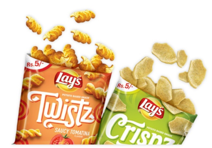The Need for Physics in Food Manufacturing
John Bows is an employee of PepsiCo Inc. The views expressed in this article are those of the author and do not necessarily reflect the position or policy of PepsiCo Inc.
It surprises many academic and industrial researchers, across the spectrum of science and engineering disciplines, that the Food and Drink manufacturing sector is the largest manufacturing sector in the UK, accounting for 20% of the UK manufacturing turnover1. This is more than the UK automotive and aerospace manufacturing sectors combined.
What isn’t surprising is that R&D spend correlates to GVA (Gross Value Added)2. Despite being the largest sector, food is not growing as fast as the automotive industry. Government intervention saw an Automotive Council established in 2009 and a Sector strategy published in 2012, with a c. 70% increase in GVA between 2008 and 2014 from a corresponding increase of 100% in R&D spend. In comparison, R&D spend on Food & Drink increased by 40% from 2008 to 2014, and GVA grew by 20%.
The need for R&D to drive the Food & Drink sectors’ needs and priorities has never been greater. With strong engagement across the food & drink supply chain, Innovate UK (the UK government’s innovation agency) published a report3 in 2018 highlighting 5 areas where research and industrial capability is needed to address the sectors “grand challenges”:
- Reducing food energy density
- Side-stream valorisation
- Sustainable new food sources for nutritional foods
- Flexible and scalable manufacturing
- Digital manufacturing
As a Physicist working in food process innovation within 2 major global companies (Unilever 1990-2005, PepsiCo since 2005), I am certainly the minority discipline - the only Physicist in PepsiCo R&D Europe. Bringing a physicist’s approach within multi-disciplinary teams can certainly strengthen innovation impact. In my case, I led the innovation of the world’s first raw rising dough microwave pizza using active antenna packaging (launched in Europe 1999)11, developed new imaging and measurement techniques with research partners (real-time dielectric measurements12 and real-time 3D X-Ray imaging13 during expansion of a snack microwave heating) and developed new process technology for lower fat snacks innovation (proprietary technology).
As the food sector pre-competitive “grand challenges” became better articulated against a backdrop of societal health & wellness needs, it struck me around 2015 that my professional body in the UK – the Institute of Physics – was not involved with the food manufacturing sector. That was quickly remedied when I connected with Anne Crean, the then newly appointed Head of Science & Innovation. Within 2 years, through a series of national engagement activities, we set-up the “Physics in Food Manufacturing” group, which I now chair10. We have had 3 international conferences since 2017, publish newsletters and present at physics conferences on food manufacturing innovation challenges.

There is also a lot of work to do in gender balance across physics – women in physics are still very much in the minority. The IOP published an excellent report with recommendation in 2018 on “Why not physics”14 looking at the lack of girls continuing physics higher education.
This is an exciting time for academic and industrial physicists to engage the food and drink manufacturing sector, with many opportunities and very interesting physics at the root of sector challenges, from mass personalisation of health & nutrition to net zero water usage factories. By building networks, relationships and ultimately working partnerships between associations like the IOP and APS, I hope more physicists can deliver breakthroughs against food manufacturing’s “grand challenges” which genuinely benefit health and wellness at societal scales.
PepsiCo R&D is engaged a wide scope of fundamental research that require multidisciplinary approaches; for example, in our Plano, TX R&D center, research areas include food/material/polymer sciences, advanced analytical techniques such as 3D-tomography and food-specific chromatographies, as well as multiphase computational fluid dynamics modeling and smart sensors. As a global company, in addition to laboratories in the UK and Texas, PepsiCo has key R&D centers located in New York, Illinois, Mexico, and Brazil, which not only allows PepsiCo to leverage the broad technical and scientific talent available across the globe, but also enables us to easily collaborate with world-class universities and research institutes.
References
1 Food and Drink Federation: https://www.fdf.org.uk/statsataglance.aspx
2 The Health of Physics in UK Food Manufacturing, October 2016 https://www.iop.org/publications/iop/2016/page_68332.html
3 Food & Drink Sector R&D Needs and Priorities: Alignment with the Industrial Strategy https://ktn-uk.co.uk/news/aligning-food-and-drink-sector-rd-needs-and-priorities-with-the-uks-industrial-strategy
4 http://www.iop.org/activity/business/innovation/2018-winners/page_72056.html
5 https://www.edwards.phy.cam.ac.uk/news/unilever
6 Physics World Nov 2016 – Physics of Food feature https://physicsworld.com/a/physics-of-food-the-november-2016-issue-of-physics-world-is-now-out/
7 Soft matter food physics – the physics of food and cooking DOI:10.1088/0034-4885/78/12/124602
8 Soft matter physics meets the culinary arts: From polymers to jellyfish DOI: 10.1016/j.ijgfs.2019.100135
9 Celebrating Soft Matter’s 10th Anniversary: Simplicity in complexity – towards a soft matter physics of caramel DOI: 10.1039/c5sm01797a
10 Physics in Food manufacturing group page https://www.iop.org/activity/groups/subject/pifm/newsletter/page_69795.html
11 Physics in Food Manufacturing Challenges - slide 13 https://gateway.newton.ac.uk/sites/default/files/asset/doc/1809/Physics%20in%20Food%20-%20Cambridge%20Soft%20Matter%20-%20Sep2018%20-%20share.pdf
12 Dynamic measurement of dielectric properties of food snack pellets during microwave expansion DOI: 10.1016/j.jfoodeng.2017.01.021
13 PepsiCo Explores Future Food Products at the ALS https://als.lbl.gov/pepsico-explores-future-food-products-als/
14 IOP Report – Why not physics? https://www.iop.org/publications/iop/2018/file_71495.pdf
John Bows, FInstP
PepsiCo Global R&D Fellow
